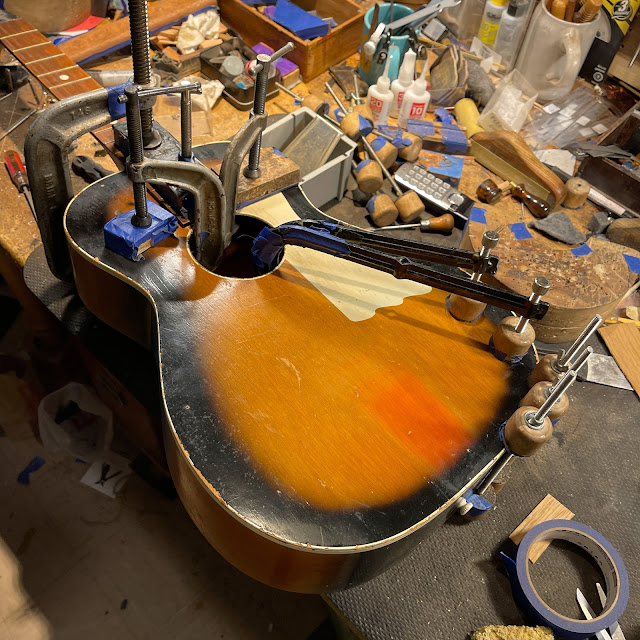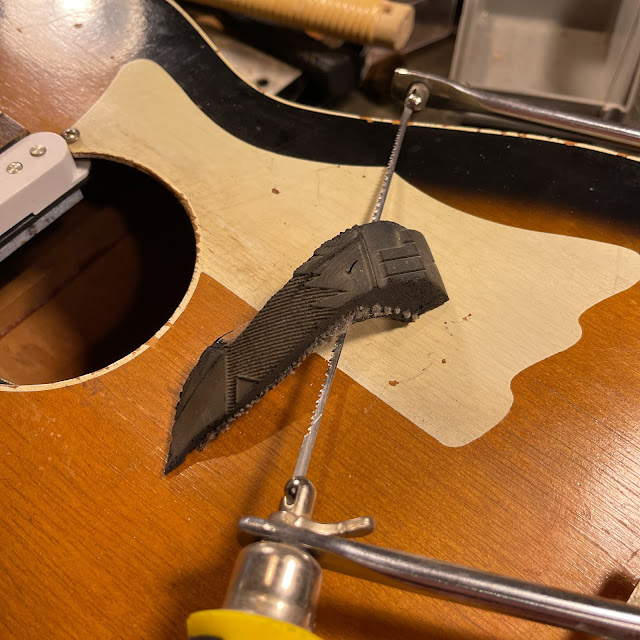1950s Airline (Harmony) Rubber Bridge Parlor Guitar
Acoustic clip (above)...
Electric clip (above)...
This guy is yet another-branded variant of the "typical Harmony parlor guitar" that's most-often seen as a Stella H929. I was traded this some time ago but an order for a couple of "rubber bridge" parlor guitars meant I had a good reason to spruce it up. Thank the gods for diversions!
Per the usual, it's solid birch throughout, 13" on the lower bout, has a poplar neck, and an ebonized maple fretboard. These have a short, 24 1/8" scale length and chunky, medium-bigger neck shapes.
It got the usual work these need, too -- a neck reset, fret level/dress, side dots, replacement tuners (relic'd Gotohs), seam repairs, minor crack repairs, bracing repairs, and setup-side work. On top of that it also got a Strat-style pickup installed at the top of the soundhole (a small barrel Dremel sanding drum makes quick work of that) and a wiring harness fit with a volume control on the bass "shoulder."
The highlight of the instrument is the "rubber bridge" which gives it a dampened, super-mellow, short-sustain voice. This is pretty popular these days and nothing else really sounds the same. Stuffing some damping foam under the strings near the bridge gets you close but you don't have the fat and round sound that this style of bridge does. Palm-muting gets you close as well, but it's awfully hard to full-on strum chords and pick melody lines freely while your hand is stuck in place.
I make my "rubber bridges" (really, rubber saddles) from a discarded truck tire that was left under our porch a decade ago. I have plenty more discarded truck tires to go through, too. I cut a slice of that and stick it on top of a normal tailpiece-style floating bridge, anchoring it with a couple of screws. I then compensate it (roughly) and slot-into it with my nut-slotting files to set the action height. At the same time, the string then plunges down into the rubber of the saddle and it's like it's being "pinched" on all sides in damping goodness as it leaves the rubber saddle and up to the nut. I find this gives it a far "thunkier" sound than simply stringing it on top of the rubber, but it's a little fussy to get right.
The Strat-style pickup is a workshop freebie leftover from my bins, but its footprint means that if the owner decides to go with something more boutique, it's as easy as dropping whatever is desired in a Strat-size shape -- which is basically every pickup sound under the sun, these days. It sounds great, though, as-is -- it's bright and accurate which means that you can get the "typical rubber bridge" sound just by rolling tone off at your amp but it remains bright-enough that you can get some good pick-smack sounds if you're recording chord-work.
Last but not least -- the cute little '50s knob is something I found in the woods, go figure!


















Comments